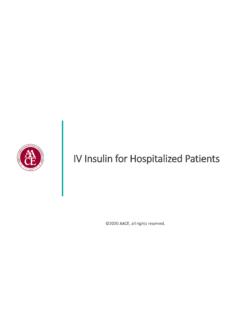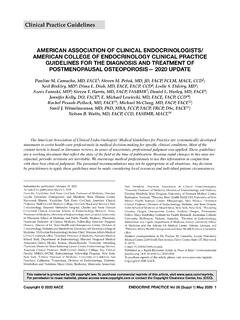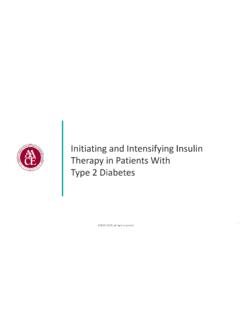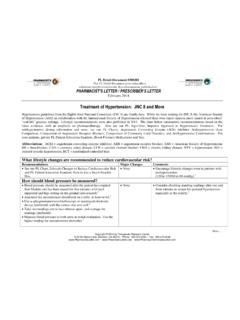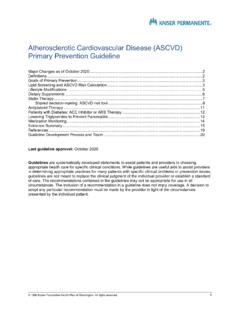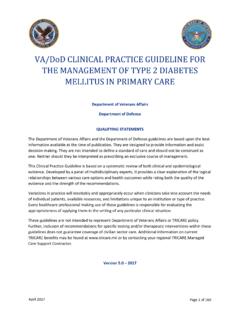Transcription of AACE COMPREHENSIVE TYPE 2 DIABETES 2 0
1 COPYRIGHT 2020 AACE | MAY NOT BE REPRODUCED IN ANY FORM WITHOUT EXPRESS WRITTEN PERMISSION FROM AACE. | DOI ASSOCIATION OF CLINICAL ENDOCRINOLOGYAACE COMPREHENSIVETYPE 2 DIABETESMANAGEMENT ALGORITHMCOPYRIGHT 2020 AACE | MAY NOT BE REPRODUCED IN ANY FORM WITHOUT EXPRESS WRITTEN PERMISSION FROM AACE. | DOI 2020 AACE | MAY NOT BE REPRODUCED IN ANY FORM WITHOUT EXPRESS WRITTEN PERMISSION FROM AACE. | DOI for Treatment of Type 2 Model for Care of the Patient with Risk Factor of Antihyperglycemic MedicationsTABLE OF CONTENTSCOMPREHENSIVE TYPE 2 DIABETES MANAGEMENT ALGORITHMCOPYRIGHT 2020 AACE | MAY NOT BE REPRODUCED IN ANY FORM WITHOUT EXPRESS WRITTEN PERMISSION FROM AACE. | DOI OF THE AACE/ACE COMPREHENSIVETYPE 2 DIABETES MANAGEMENT modification underlies all therapy ( , weight control, physical activity, sleep, etc.) weight all glycemic targets (A1C, FPG, PPG) A1C is , or as close to normal as is safe and choices are patient centric based on A1C at presentation and shared of therapy reflects ASCVD, CHF, and renal must be managed for COMPREHENSIVE to goal as soon as possible adjust at 3 months until at of therapy includes ease of use and is highly recommended, as available, to assist patients in reaching goals safelyCOPYRIGHT 2020 AACE | MAY NOT BE REPRODUCED IN ANY FORM WITHOUT EXPRESS WRITTEN PERMISSION FROM AACE.
2 | DOI THERAPYRISK STRATIFICATION FOR DIABETES COMPLICATIONSN utrition PhysicalActivitySleepBehavioral SupportSmokingCessation Structured counseling Meal replacement+ Medical evaluation/clearance Medical supervision Referral to sleep study Formal behavioral therapy Referral to structured program+++++++++INTENSITY STRATIFIED BY BURDEN OF OBESITY AND RELATED COMPLICATIONS Avoid trans fatty acids; limit saturated fatty acids Technological aids Structured program Wearable technologies Screen sleep disturbances Home sleep study Discuss mood with HCP Nicotine replacement therapy and medica-tions as tolerated Maintain optimal weight Calorie restriction (manage increased weight) Plant-based diet; high polyunsaturated and monounsaturated fatty acids 150 min/week moderate exertion ( , walking, stair climbing) Strength training Increase as tolerated About 6-8 hours per night Basic sleep hygiene Community engagement Alcohol moderation No tobacco productsCOPYRIGHT 2020 AACE | MAY NOT BE REPRODUCED IN ANY FORM WITHOUT EXPRESS WRITTEN PERMISSION FROM AACE.
3 | DOI 1 EVALUATION FOR COMPLICATIONS AND STAGINGP hysician/RD counseling, web/remote program, structured multidisciplinary programLifestyle Therapy:MedicalTherapy(BMI 27):Endoscopic procedures, gastric banding, sleeve, or bypassSurgical Therapy (BMI 35):STEP 3 CARDIOMETABOLIC DISEASE | BIOMECHANICAL COMPLICATIONST herapeutic targets forimprovement in complicationsSTEP 2 TreatmentmodalityTreatment intensity basedon staging++Individualize care by selecting one of the following based on efficacy, safety,and patients clinical profile: phentermine, orlistat, lorcaserin,phentermine/topiramate ER, naltrexone/bupropion, liraglutide 3 mgIf therapeutic targets for complications not met, intensify lifestyle , medical, and/or surgical treatmentmodalities for greater weight loss. Obesity is a chronic progressive disease and requires commitment to long-term therapy and 0 SEVEREBMI 25 STAGE 2 STAGE 1 MILD TO MODERATEOVERWEIGHT OR OBESITYNO COMPLICATIONSCOMPLICATIONSNO OVERWEIGHTOR OBESITYBMI 25 SELECT:BMI <25 COMPLICATIONS-CENTRIC MODEL FOR CARE OF THE PATIENT WITH OVERWEIGHT/OBESITY (ADIPOSITY-BASED CHRONIC DISEASE)COPYRIGHT 2020 AACE | MAY NOT BE REPRODUCED IN ANY FORM WITHOUT EXPRESS WRITTEN PERMISSION FROM AACE.
4 | DOI withCautionTREAT HYPERGLYCEMIAFPG >100 | 2-hour PG >140 TREAT ASCVDRISK FACTORSO rlistat, lorcaserin,phentermine/topiramate ER,naltrexone/bupropion, liraglutide 3 mg,or bariatric surgery as indicatedfor obesity treatmentLEGENDMULTIPLE PRE-DMCRITERIALow-riskMedicationsMetform inAcarboseWEIGHT LOSSTHERAPIESASCVD RISK FACTORMODIFICATIONS ALGORITHM1 PRE-DMCRITERIONLIFESTYLE THERAPY(Including Medically Assisted Weight Loss)PROCEED TOGLYCEMIC CONTROLALGORITHMHYPERTENSIONROUTEDYSLIPI DEMIAROUTEIf hyperglycemia persistsPREDIABETES ALGORITHMIFG (100 125) | IGT (140 199) | METABOLIC SYNDROME (NCEP 2001)COPYRIGHT 2020 AACE | MAY NOT BE REPRODUCED IN ANY FORM WITHOUT EXPRESS WRITTEN PERMISSION FROM AACE. | DOI statin-intolerantIntensify therapies to attain goals accordingto risk levelsAssess adequacy & tolerance of therapy with focused laboratory evaluations and patient follow-upHYPERTENSIONI ntensify lifestyle therapy (weight loss, physical activity, dietarychanges) and glycemic control.
5 Consider additional therapyTo lower LDL-C: Intensify statin, add ezetimibe, PCSK9i, colesevelam, or niacinTo lower Non-HDL-C, TG: Intensify statin and/or add Rx-grade OM3 fatty acid, fibrate, and/or niacinTo lower Apo B, LDL-P: Intensify statin and/or add ezetimibe, PCSK9i, colesevelam, and/or niacinTo lower LDL-C in FH:** Statin + PCSK9iAdditional choices ( -blockers,central agents, vasodilators,aldosterone antagonist)GOAL: SYSTOLIC <130,DIASTOLIC <80 mm H gACEiorARBC alciumChannelBlocker -blockerThiazideACEiorARBIf not at goal (2 3 months)If not at goal (2 3 months)If not at goal (2 3 months)* EVEN MORE INTENSIVE THERAPY MIGHT BE WARRANTED ** FAMILIAL HYPERCHOLESTEROLEMIALIPID PANEL: Assess ASCVD RiskAchievement of target bloodpressure is criticalAdd next agent from the abovegroup, repeatSTATIN THERAPYIf TG >500 mg/dL, fibrates, Rx-grade OM-3 fatty acids, niacinLIFESTYLE THERAPY (Including Medically Assisted Weight Loss)If not at desirable levels: Add icosapent ethyl 4 g/day if high ASCVD risk on maximally tolerated statinsIf TG 135-499:Add calcium channel blocker, -blocker or thiazide diureticASCVD RISK FACTOR MODIFICATIONS ALGORITHMRISK LEVELSHIGHVERY HIGHEXTREMEDESIRABLE L E VELSDESIRABLE L E VELSDESIRABLE L E VELSLDL-C (mg/dL)<100<70<55 Non-HDL-C (mg/dL)<130<100<80TG (mg/dL)<150<150<150 Apo B (mg/dL)<90<80<70 RISK LEVELS:HIGH*:DM but no other majorrisk and/or age <40 VERY HIGH*:DM + major ASCVD risk(s) (HTN, Fam Hx,low HDL-C, smoking, CKD3,4)EXTREME*:DM plus establishedclinical CVDTry alternate statin, lower statindose or frequency, or add nonstatinLDL-C- lowering therapiesRepeat lipid panel.
6 Assess adequacy,tolerance of therapyFor initial blood pressure>150/100 mm Hg:DUAL THERAPYCOPYRIGHT 2020 AACE | MAY NOT BE REPRODUCED IN ANY FORM WITHOUT EXPRESS WRITTEN PERMISSION FROM AACE. | DOI OtherAgentsADD OR INTENSIFYINSULINR efer to Insulin AlgorithmLEGENDFew adverse events and/orpossible benefitsUse with cautionEntry A1C > Order of medications represents a suggested hierarchy of usage; length of line reflects strength of recommendation2 If not at goal in 3 months, proceed to next level therapy*CKD 3: canagliflozin; HFrEF: dapagliflozinCKD 3 = stage 3 chronic kidney disease; HFrEF = heart failure with reduced ejection fraction; LA = long-acting ( 24 hour duration)A1C patients without concurrent serious illness and at low hypoglycemic riskA1C > patients with concurrent seriousillness and at risk for hypoglycemiaINDIVIDUALIZEGOALSE ntry A1C - THERAPY AND ONGOING GLUCOSE MONITORING (CGM preferred)INDEPENDENT OF GLYCEMIC CONTROL, IF ESTABLISHED OR HIGH ASCVD RISK AND/OR CKD, RECOMMEND SGLT2i AND/OR LA GLP1-RAPROGRESSION OF DISEASEGLYCEMIC CONTROL ALGORITHMMETor other agentDUAL THERAPY1 GLP1-RASGLT2iDPP4iTZDSU/GLNB asal InsulinColesevelamBromocriptine QRAGiNOYESSYMPTOMSE ntry A1C < ,2 MetforminGLP1-RASGLT2iDPP4iTZDAGiSU/GLNG LP1-RASGLT2iTZDSU/GLNB asal InsulinDPP4iColesevelamBromocriptine QRAGiTRIPLE THERAPY1+3 MONTHS23 MONTHS2 Independent of glycemic control, if established ASCVD or high risk, CKD 3, or HFrEF, start LA GLP1-RA or SGLT2i with proven efficacy*COPYRIGHT 2020 AACE | MAY NOT BE REPRODUCED IN ANY FORM WITHOUT EXPRESS WRITTEN PERMISSION FROM AACE.
7 | DOI 2020 AACE | MAY NOT BE REPRODUCED IN ANY FORM WITHOUT EXPRESS WRITTEN PERMISSION FROM AACE. | DOI <7% for most patients with T2D; fasting and premeal BG <110 mg/dL; absence of hypoglycemia A1C and FBG targets may be adjusted based on patient s age, duration of DIABETES , presence of comorbidities, diabetic complications, and hypoglycemia risk Fixed regimen: Increase TDD by 2 U Adjustable regimen: FBG >180 mg/dL: add 20% of TDD FBG 140 180 mg/dL: add 10% of TDD FBG 110 139 mg/dL: add 1 unit If hypoglycemia, reduce TDD by: BG <70 mg/dL: 10% 20% BG <40 mg/dL: 20% 40%*Glycemic Goal:A1C <8%A1C >8%START BASAL (Long-Acting Insulin)Consider discontinuing or reducing sulfonylurea afterstarting basal insulin (basal analogs preferred to NPH) U/kgInsulin titration every 2 3 daysto reach glycemic goal:GlycemicControl Notat Goal*Basal Plus 1,Plus 2, Plus 3 Basal BolusAdd Prandial Insulin Begin prandial insulin before largest meal If not at goal, progress to injections before 2 or 3 meals Start: 10% of basal dose or 5 units Start.
8 50% of TDD in three doses before meals Begin prandial insulin before each meal 50% Basal / 50% Prandial TDD U/kgInsulin titration every 2 3 days to reach glycemic goal: Increase prandial dose by 10% or 1-2 units if 2-h postprandial or next premeal glucose consistently >140 mg/dL If hypoglycemia, reduce TDD basal and/or prandial insulin by: BG consistently <70 mg/dL: 10% - 20% Severe hypoglycemia (requiring assistance from another person) or BG <40 mg/dL: 20% - 40%AddGLP1-RAOr SGLT2iOr DPP4iTDDTDDINTENSIFY (Prandial Control) algorithm FOR ADDING/INTENSIFYING INSULINCOPYRIGHT 2020 AACE | MAY NOT BE REPRODUCED IN ANY FORM WITHOUT EXPRESS WRITTEN PERMISSION FROM AACE. | DOI (moderate dose)COLSVLBCR-QRINSULINPRAMLHYPON eutralNeutralNeutralNeutralNeutralNeutra lNeutralNeutralModerate to SevereNeutralWEIGHTS light LossLossLossNeutralNeutralGainGainNeutra lNeutralGainLossRENAL / GUContra-indicated if eGFR <30 mL/min/ m2 ExenatideNotIndicatedCrCl <30 Not Indicated foreGFR <45 mL/ m2 DoseAdjustmentNecessary(ExceptLinaglipti n)Effective inReducingAlbuminuriaNeutralNeutralMoreH ypo RiskNeutralNeutralMoreHypo RiskNeutralSee #1 Genital MycoticInfectionsPotential Benefit of LA GLP1-RAPotential CKD Benefit; See #1GI SxModerateModerateNeutralNeutralModerate NeutralNeutralMildModerateNeutralModerat eCHFN eutralNeutralPrevent HF HospitalizationManage HFrEF.
9 See #2 See #4 NeutralModerateNeutralNeutralNeutralCHF RiskNeutralMay Reduce Stroke RiskPossible ASCVD RiskLowers LDL-CSafeNeutralASCVDP otential Benefit of LA GLP1-RASee #3 BONEN eutralNeutralNeutralNeutralNeutralModera teFractureRiskNeutralNeutralNeutralNeutr alNeutralKETOACIDOSISN eutralNeutralDKA Can Occurin VariousStress SettingsNeutralNeutralNeutralNeutralNeut ralNeutralNeutralNeutralPROFILES OF ANTIHYPERGLYCEMIC MEDICATIONSSUMildFew adverse events or possible benefitsUse with cautionLikelihood of adverse effectsGLNM oderate/SevereCARDIAC1. Canagliflozin indicated for eGFR 30 mL/ m2 in patients with CKD 3 + Dapagliflozin potential primary prevention of HF hospitalization & demonstrated efficacy in Empagliflozin FDA approved to reduce CV mortality. Canagliflozin FDA approved to reduce MACE Possible increased hospitalizations for heart failure with alogliptin and 2020 AACE | MAY NOT BE REPRODUCED IN ANY FORM WITHOUT EXPRESS WRITTEN PERMISSION FROM AACE.
10
